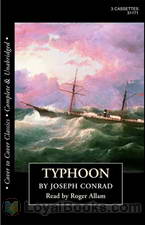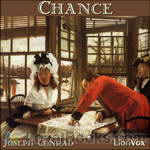By: Joseph Conrad (1857-1924) |
|---|
 Typhoon
Typhoon
First published in 1902 as a serial in Pall Mall Magazine, the adventure novel follows the disrupting events onboard a steamboat after it takes a perilous course at sea, which triggers a state of mayhem onboard the steamer. Furthermore, the incident prompts the crew to gradually reveal their true nature which is brought to light in the time of crisis. Interestingly, the tale is believed to possess some autobiographical elements taken from Conrad’s own experiences at sea, which provide the novel with a strong foundation, as he effectively uses personification, imagery, and descriptive language to accurately illustrate the danger and chaos instigated by a powerful storm at sea...
|
 The Mirror of the Sea
The Mirror of the Sea
The Mirror of the Sea is a collection of autobiographical essays first published in various magazines 1904-6. Conrad early in his life earned his bread as a Master Mariner in sailing ships. In his Author’s Note to this work, Conrad states,”Beyond the line of the sea horizon the world for me did not exist….Within these pages I make a full confession not of my sins but of my emotions. It is the best tribute my piety can offer to the ultimate shapers of my character, convictions, and, in a sense, destiny—to the imperishable sea, to the ships that are no more, and to the simple men who have had their day.”
|
 Nostromo
Nostromo
Señor Gould is a native Costaguanan of English descent who owns the silver-mining concession in Sulaco. He is tired of the political instability in Costaguana and its concomitant corruption, and puts his weight behind the Ribierist project, which he believes will finally bring stability to the country after years of misrule and tyranny by self-serving dictators. Instead, the silver mine and the wealth it has generated become a magnet for local warlords to fight over, plunging Costaguana into a new round of chaos...
|
 The Secret Sharer
The Secret Sharer
A young untested ship captain finds a man named Leggatt clinging to the side of his ship. The Captain makes the unusual decision to hide Leggatt in his quarters. What is he thinking? Conrad will tell us. - The Secret Sharer was first published in the August and September 1910 issues of Harper’s Magazine
|
 Chance
Chance
Apparently a two part story about a Damsel and a Knight, perhaps a damsel who depends upon the kindness of strangers. It was originally entitled "Dynamite" and first published by installments in the New York Herald. The book itself was the biggest commercial success for Conrad up until that time, 1913. It allowed Conrad for the first time to settle his financial affairs. The author's disdain for people who live on the land is apparent. A new understanding of the word "enthusiastic" is promulgated. And it is a love story. Let us see how the tale goes.
|
 An Outcast Of The Islands
An Outcast Of The Islands
An Outcast of the Islands is the second novel by Joseph Conrad, published in 1896, inspired by Conrad's experience as mate of a steamer, the Vigar. The novel details the undoing of Peter Willems, a disreputable, immoral man who, on the run from a scandal in Makassar, finds refuge in a hidden native village, only to betray his benefactors over lust for the tribal chief's daughter. The story features Conrad's recurring character Tom Lingard, who also appears in Almayer's Folly (1895) and The Rescue (1920), in addition to sharing other characters with those novels...
|
 Shadow-Line
Shadow-Line
Dedicated to the author's son who was wounded in World War 1, The Shadow-Line is a short novel based at sea by Joseph Conrad; it is one of his later works, being written from February to December 1915. It was first published in 1916 as a serial and in book form in 1917. The novella depicts the development of a young man upon taking a captaincy in the Orient, with the shadow line of the title representing the threshold of this development. The novella is notable for its dual narrative structure. The full, subtitled title of the novel is The Shadow-Line, A Confession, which immediately alerts the reader to the retrospective nature of the novella...
|
 A Voyage Towards the South Pole and Round the World
A Voyage Towards the South Pole and Round the World
 The Two Admirals
The Two Admirals
 Through St. Dunstan's to Light
Through St. Dunstan's to Light
 The Search for the Silver City A Tale of Adventure in Yucatan
The Search for the Silver City A Tale of Adventure in Yucatan
 An Essay on the Shaking Palsy
An Essay on the Shaking Palsy
 The Romance of the Coast
The Romance of the Coast
 The Meadow-Brook Girls by the Sea Or The Loss of The Lonesome Bar
The Meadow-Brook Girls by the Sea Or The Loss of The Lonesome Bar
 Confessions
Confessions
 The Confessions of J. J. Rousseau
The Confessions of J. J. Rousseau
 Uncle Rutherford's Nieces A Story for Girls
Uncle Rutherford's Nieces A Story for Girls
 The Ghost Ship
The Ghost Ship
 Afloat at Last A Sailor Boy's Log of his Life at Sea
Afloat at Last A Sailor Boy's Log of his Life at Sea
 The Penang Pirate and, The Lost Pinnace
The Penang Pirate and, The Lost Pinnace
 The Island Treasure
The Island Treasure
 The Wreck of the Nancy Bell Cast Away on Kerguelen Land
The Wreck of the Nancy Bell Cast Away on Kerguelen Land
 Picked up at Sea The Gold Miners of Minturne Creek
Picked up at Sea The Gold Miners of Minturne Creek
 Crown and Anchor Under the Pen'ant
Crown and Anchor Under the Pen'ant
 The White Squall A Story of the Sargasso Sea
The White Squall A Story of the Sargasso Sea
 On Board the Esmeralda Martin Leigh's Log - A Sea Story
On Board the Esmeralda Martin Leigh's Log - A Sea Story
 Teddy The Story of a Little Pickle
Teddy The Story of a Little Pickle
 Young Tom Bowling The Boys of the British Navy
Young Tom Bowling The Boys of the British Navy
 Cases of Organic Diseases of the Heart
Cases of Organic Diseases of the Heart
 Appendicitis
Appendicitis
 Famous Sea Fights
Famous Sea Fights
 Jack in the Forecastle or, Incidents in the Early Life of Hawser Martingale
Jack in the Forecastle or, Incidents in the Early Life of Hawser Martingale
 Typhoon
Typhoon
 The Mirror of the Sea
The Mirror of the Sea
 Nostromo
Nostromo
 The Secret Sharer
The Secret Sharer
 Chance
Chance
 An Outcast Of The Islands
An Outcast Of The Islands
 Shadow-Line
Shadow-Line